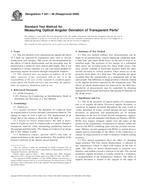Wir benötigen Ihre Einwilligung zur Verwendung der einzelnen Daten, damit Sie unter anderem Informationen zu Ihren Interessen einsehen können. Klicken Sie auf "OK", um Ihre Zustimmung zu erteilen.
ASTM F801-96(2008)
Standard Test Method for Measuring Optical Angular Deviation of Transparent Parts
Automatische name übersetzung:
Standard Test Methode zur Messung Optische Winkelabweichung Transparente Teile
NORM herausgegeben am 1.4.2008
Informationen über die Norm:
Bezeichnung normen: ASTM F801-96(2008)
Anmerkung: UNGÜLTIG
Ausgabedatum normen: 1.4.2008
SKU: NS-56487
Zahl der Seiten: 9
Gewicht ca.: 27 g (0.06 Pfund)
Land: Amerikanische technische Norm
Kategorie: Technische Normen ASTM
Kategorie - ähnliche Normen:
Die Annotation des Normtextes ASTM F801-96(2008) :
Keywords:
aiming accuracy, aiming error, angular deviation, deviation, refraction, Aerospace transparent enclosures, Angular deviation, Canopies (aerospace applications), Collimator/collimation, Deviation, Lateral displacement, Linear displacement, Optical materials/properties/tests--aerospace materials, Optoelectronic method, Windshields, ICS Number Code 49.035 (Components for aerospace construction)
Ergänzende Informationen
| Significance and Use | ||||||
|
One of the measures of optical quality of a transparent part is its angular deviation. Excessive angular deviation, or variations in angular deviation throughout the part, result in visible distortion of scenes viewed through the part. Angular deviation, its detection, and quantification are of extreme importance in the area of certain aircraft transparency applications, that is, aircraft equipped with Heads-up Displays (HUD). HUDs may require stringent control over the optics of the portion of the transparency (windscreen or canopy) which lies between the HUD combining glass and the external environment. Military aircraft equipped with HUDs or similar devices require precise knowledge of the effects of the windscreen or canopy on image position in order to maintain weapons aiming accuracy. Two optical parameters have the effect of changing image position. The first, lateral displacement, is inherent in any transparency which is tilted with respect to the line of sight. The effect of lateral displacement is constant over distance, and seldom exceeds a fraction of an inch. The second parameter, angular deviation, is usually caused by a wedginess or nonparallelism of the transparency surfaces. The effect of angular deviation is related to the tangent of the angle of deviation, thus the magnitude of the image position displacement increases as does the distance between image and transparency. The quantification of angular deviation is then the more critical of the two parameters. |
||||||
| 1. Scope | ||||||
|
1.1 This test method covers measuring the angular deviation of a light ray imposed by transparent parts such as aircraft windscreens and canopies. The results are uncontaminated by the effects of lateral displacement, and the procedure may be performed in a relatively short optical path length. This is not intended as a referee standard. It is one convenient method for measuring angular deviations through transparent windows. 1.2 This standard does not purport to address all of the safety concerns, if any, associated with its use. It is the responsibility of the user of this standard to establish appropriate safety and health practices and determine the applicability of regulatory limitations prior to use. |
||||||
| 2. Referenced Documents | ||||||
|
Ähnliche Normen:
Historisch
15.6.2012
Historisch
1.7.2007
Historisch
1.12.2011
Historisch
1.6.2009
Historisch
1.12.2011
Historisch
1.12.2010
Empfehlungen:
EEviZak – alle Gesetze einschließlich ihrer Evidenz in einer Stelle
Bereitstellung von aktuellen Informationen über legislative Vorschriften in der Sammlung der Gesetze bis zum Jahr 1945.
Aktualisierung 2x pro Monat!
Brauchen Sie mehr Informationen? Sehen Sie sich diese Seite an.



 ASTM E2580-12
ASTM E2580-12 ASTM E2582-07
ASTM E2582-07 ASTM E2660-11
ASTM E2660-11 ASTM E2662-09
ASTM E2662-09 ASTM E2669-11
ASTM E2669-11 ASTM F2563-06(2010)..
ASTM F2563-06(2010)..
 Cookies
Cookies
